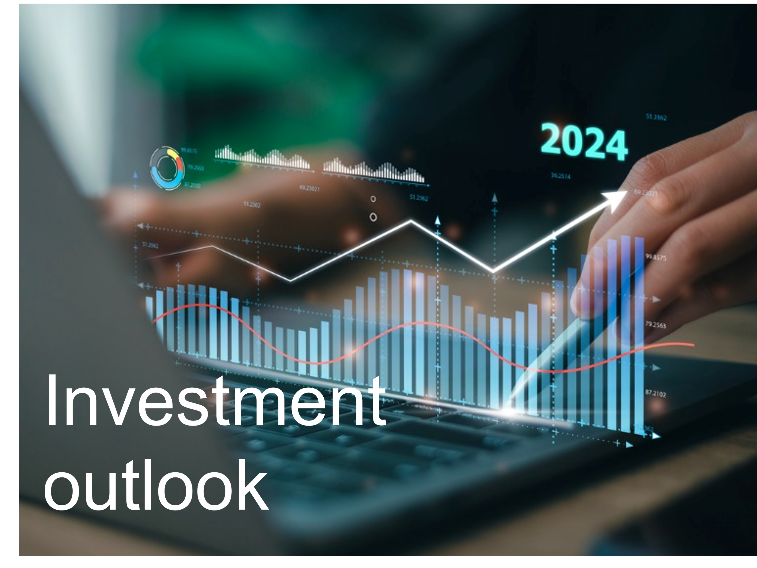We've captured the standout insights from the event series in an investor-ready eBook.


Report
With rising interest rates and geopolitical tensions, fixed income emerges as a compelling investment option for 2024.

Global growth is expected to be sub-trend next year and central banks may not ease as quickly as the market currently anticipates. At JBWere, we believe a more defensive positioning across multi-asset portfolios is appropriate as we head into 2024.
In all major economies, growth is expected to slow or at best, be broadly similar in 2024 relative to 2023. In aggregate, the global economy will register sub-trend growth in the year ahead. Inflation is expected to be lower in 2024 vs. 2023 in most major economies, except China.
For equity markets, we see upside capped by above average valuations and earnings estimates that already imply a soft landing. However, the downside is likely to be limited by central bank easing at some point later in 2024.
Fixed income will continue to remain a key component of portfolios in the year ahead given current attractive valuations. We prefer long duration positions in government bonds and exposures in high quality Australian dollar credit to anchor the fixed income component of portfolios.
While markets will focus on the US presidential election in November, it is worth noting that 2024 brings 40 national elections in total; just over 40% of the world’s population will cast a vote for (or against) a new national leader. Some of these take place in significant economies, including India, Indonesia, Brazil, Russia and Taiwan.
Locally, we continue to highlight the risk of a late cycle tightening from the RBA in the first half of the year, and the possibility of a deeper slowdown in the economy than market consensus currently expects. We are positive on AUD/USD, but see material upside capped by a weak case for significant USD depreciation and the possibility that softer global growth forces an early end to the current expansion.
As always, there are risks to the outlook. Five wildcards we identify for 2024 include:
The new Reserve Bank of Australia governor, Michelle Bullock, put the proverbial cat among the pigeons in late November 2023, when she delivered a hawkish speech outlining her thesis that Australia’s inflation challenges were homegrown.
As we observed at the time, the main implication of her argument is that the tightening cycle may not be over because aggregate demand and aggregate supply are yet to align.
Another way to think about the outlook for the economy and interest rates is to compare the level of interest rates in Australia compared to peer economies. Currently, Australia’s policy rate is well below the average across our peer economies, including the US, UK, New Zealand and Canada.
We continue to believe the RBA may have more work to do on rates. Moreover, we observe that for most peer economies with a cash rate circa 5%, inflation is now quite a bit closer to target and unemployment rates are starting to rise. This is not yet the case in Australia.
For the economy, the spectre of late cycle tightening is likely to impact household consumption disproportionately relative to other sectors of the economy. But as household spending is about 55% of the overall economy, a slowing in this sector will be felt everywhere.
The home-grown nature of Australia’s inflation challenge implies the sacrifice required of the broader economy and labour markets in order to bring inflation down may be larger than might be the case offshore.
Strong population growth will likely mean that a technical recession is avoided in Australia; regardless, we don’t think it an overly useful distinction for helping to think about asset allocation and investment opportunities. The key point is simply that the risk of a more difficult economic outcome in 2024 is higher than currently priced by bond and equity markets in Australia. This risk bias leaves us positive on AUS duration and high-quality credit, and still defensively positioned in Australian equities.
To discover more call 1300 683 106 or email us on investordesk@nab.com.au
Important information
The information contained in this article is gathered from multiple sources believed to be reliable as at December 2023 and is intended to be of a general nature only. It has been prepared without taking into account any person’s objectives, financial situation or needs. NAB and JBWere do not guarantee the accuracy or reliability of any information in this article which is stated or provided by a third party. Before acting on this information, NAB and JBWere recommend that you consider whether it is appropriate for your circumstances. NAB and JBWere recommend that you seek independent legal, property, financial and taxation advice before acting on any information in this article.
JBWere Limited ABN 68 137 978 360 AFSL No. 341162 (JBWere)is a wholly owned subsidiary of NAB. JBWere’s obligations do not represent deposits or other liabilities of NAB. NAB does not guarantee its subsidiaries’ obligations or performance, or the products or services its subsidiaries offer. You may be exposed to investment risk, including loss of income and principal invested.
©2023 NAB Private Wealth is a division of National Australia Bank Limited ABN 12 004 044 937 AFSL and Australian Credit Licence 230686. ©2023 JBWere Limited ABN 68 137 978 360 AFSL No. 341162.
All information in this article is intended to be accessed by the following persons ‘Wholesale Clients’ as defined by the Corporations Act. This article should not be construed as a recommendation to acquire or dispose of any investments.
© National Australia Bank Limited. ABN 12 004 044 937 AFSL and Australian Credit Licence 230686.